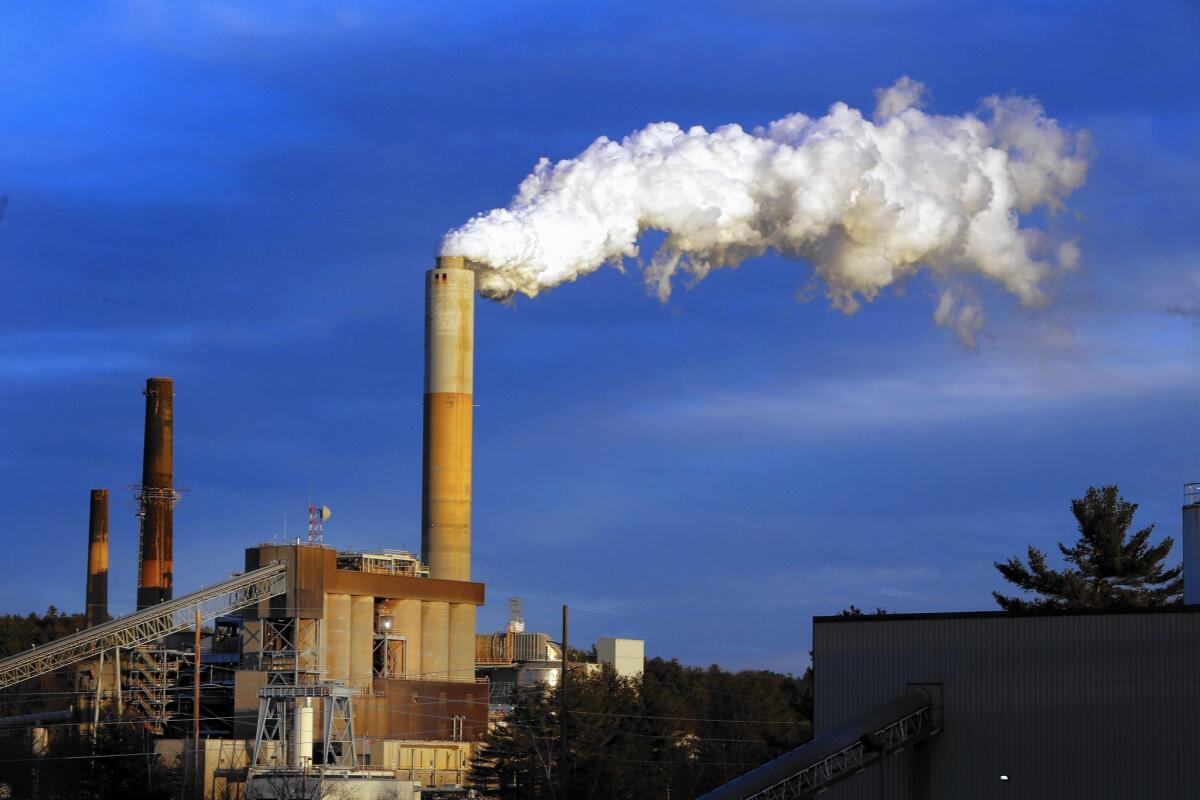California is ahead of the game as Obama releases Clean Power Plan

President Obamaâs plan to cut carbon pollution from power plants over the next 15 years will force states to address climate change by pushing them to act more like California.
The Clean Power Plan announced Monday poses significant challenges for states that rely on coal-fired power plants for much of their electricity, but complying with the rules will be a breeze for California. Thatâs because the state has practically eliminated coal from its energy portfolio and leads the nation with the toughest regulations to cut the greenhouse gas emissions that are warming the planet.
California officials said Monday that their existing climate change programs put the state on course to meet the U.S. Environmental Protection Agencyâs new carbon-dioxide emissions target years ahead of schedule.
Gov. Jerry Brown welcomed the presidentâs âbold and absolutely necessary carbon reduction plan.â
If anything, the federal governmentâs measures could accelerate the transition to solar, wind and other renewable energy sources that was spurred on by Californiaâs policies, experts said. And green business groups said the EPAâs rules are likely to boost the California economy, which is at the forefront of developing technology for renewable energy and efficiency.
âThis is going to expand the markets that California policies have worked to establish,â said Mary Solecki, Western states advocate for Environmental Entrepreneurs, a nonprofit advocacy group of business leaders.
Nationwide, the new climate change regulations are expected to cut the electricity sectorâs greenhouse gas emissions 32% below 2005 levels by 2030, according to EPA estimates. The rules, issued under the federal Clean Air Act, give each state its own pollution reduction goal and allow each to choose the measures it will use to comply.
The new rules wonât have much direct effect on California because they are less stringent than the carbon-cutting targets already on the books. State regulators have for years targeted carbon emissions with strict standards on vehicle emissions, energy efficiency, low-carbon fuels and renewable power. Key to Californiaâs efforts is the cap-and-trade program to cut greenhouse gas emissions from power plants, factories, transportation fuels and other major sources.
An analysis of the EPAâs proposed carbon plan last year by the California Air Resources Board found the state could meet its federal emissions target as much as 10 years early, in 2020, just by fully executing existing climate change programs.
âWeâre going to be able to comply and even over-comply,â said Edie Chang, who oversees the resource boardâs climate change programs.
California is on track to cut greenhouse gas emissions to 1990 levels by 2020 as required under AB 32, its landmark 2006 global warming law. Earlier this year, Brown issued an executive order that would continue that trend, setting a target of reducing emissions by 40% from 1990 levels by 2030.
In 2013, the most recent year available, nearly 19% of Californiaâs electricity came from renewable sources, while less than 8% came from coal, according to the California Energy Commission. In January, Brown proposed an ambitious target of 50% renewables by 2030.
Obamaâs climate plan faces fierce resistance from lawmakers and industry groups in Midwestern and Southern states that rely heavily on coal. They say the regulations will bring job losses and economic harm.
But in California, some of the largest utilities, including the Los Angeles Department of Water and Power, applauded the plan.
Solar and wind industry trade groups said Obamaâs plan could foster more regional cooperation, with potential for some states to develop renewable energy projects to trade the emissions reductions with their neighbors.
Read the latest Essential California newsletter >>
âThe EPA rules are going to drive a lot of renewable energy investments in the rest of the country, including Western states that border California,â said Tom Darin, senior director of Western state policy for the American Wind Energy Assn., an industry trade group.
When President Obama announced the regulations, he noted the success of clean-air policies in California. Obama recalled being a student at Occidental College more than three decades ago, when L.A.âs smog made it hard to breathe when he went out for a run.
âYou fast-forward 30, 40 years later, and we solved those problems,â he said.
âAt the time, the same time, the same characters who are going to be criticizing this plan were saying this is going to kill jobs. Despite those scaremongering tactics,â he added, âyou can actually run in Los Angeles without choking.â
State Sen. Fran Pavley (D-Agoura Hills), a leading voice on climate change in the California Legislature, said âa national policy would help us defend ourselves against opposition claims that businesses will move out of state for cheaper coal-fired electricity.â
Pavley said opponents of Californiaâs policy have argued that it is unimportant because the stateâs emissions are a small percentage of the global total.
âNow, with Obamaâs announcement, the opposition from the coal companies will be that the United States is just a small part of world greenhouse gas emissions,â Pavley said. âHere we go again.â
Twitter: @tonybarboza
Times staff writers Christi Parsons in Washington, D.C., and Patrick McGreevy in Sacramento contributed to this report.
Hoy: Léa esta historia en español
MORE COVERAGE ON CLIMATE CHANGE POLICY:
How bad was L.A.âs smog when Barack Obama went to college here?
Obama recalls college-years jog in smoggy L.A. as he lays out new climate-change plan







